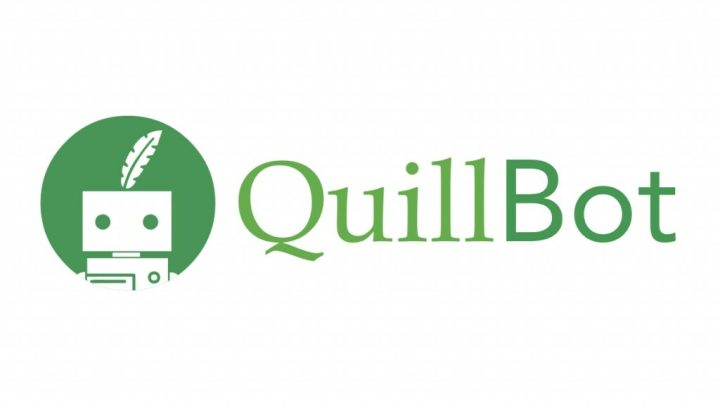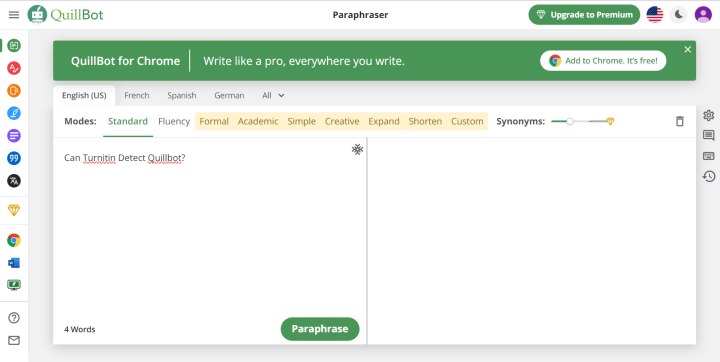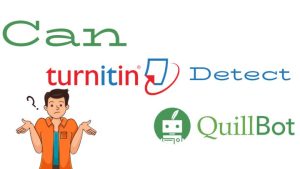Plagiarism detection in academic and professional writing plays a pivotal role in upholding the integrity and originality of ideas. It is a critical safeguard against intellectual dishonesty and ensures knowledge is built on honesty and authenticity. As the digital age has made information readily accessible, the temptation to copy and paste has grown, making plagiarism a pressing concern. In recent years, the landscape of writing assistance has changed with the rise of AI-driven tools like Quillbot. These AI-powered platforms have garnered immense popularity among students and writers alike. Quillbot, for instance, leverages advanced natural language processing algorithms to assist users in improving their writing, paraphrasing sentences, and ensuring content uniqueness. We have written about the most asked question: Can Turnitin Detect Quillbot?
While these tools are valuable aids in enhancing the quality of one’s work, they also pose a challenge when it comes to maintaining academic and professional integrity. This is where plagiarism detection software like Turnitin comes into play. Widely adopted by educational institutions and professionals, Turnitin scans documents for similarities against a vast database of academic and web content, flagging potential instances of plagiarism. It helps educators and organizations maintain high standards of originality while educating individuals about the importance of proper citation and attribution.
What will you see here?
Understanding Turnitin

Turnitin is a widely used plagiarism detection and prevention tool employed by educational institutions worldwide. Its primary purpose is to ensure academic integrity by identifying instances of plagiarism in students’ written work. Turnitin operates by using a sophisticated algorithm that compares submitted papers to a vast database of educational content, including previously submitted student papers, publications, websites, and a wide array of textual sources. When a student submits an essay or paper, Turnitin’s system scans the text for similarities to content in its database.
Key features and mechanisms that Turnitin uses to detect plagiarism include:
Originality Reports: Turnitin generates originality reports for submitted papers, highlighting any matches or similarities in its extensive database. These reports provide educators and students with a clear view of potentially plagiarized content.
Similarity Index: Turnitin assigns a similarity score or percentage to each submitted paper, indicating the degree of overlap with existing sources. Educators can use this score to assess the authenticity of the work.
Citation and Referencing Checks: Turnitin can identify improper citations, missing references, and citation errors, helping students learn proper citation techniques.
Institutional Databases: Many educational institutions maintain databases of student submissions, and Turnitin can integrate with these databases to enhance its plagiarism detection capabilities within the institution.
Exploring Quillbot

Quillbot, the AI-powered writing assistant, is a transformative force in the writing world. Poised to revolutionize the way we craft content. We are leveraging sophisticated natural language processing techniques. Quillbot empowers users in multiple facets of writing, making it an invaluable companion for writers of all backgrounds and professions. Quillbot shines in paraphrasing by skillfully rephrasing sentences and paragraphs while preserving the core meaning. This capability is a bulwark against plagiarism, enabling users to infuse their work with a distinctive voice.
Grammar correction is another forte, with real-time suggestions that catch spelling mistakes. Punctuation slip-ups and grammatical blunders, ensuring the utmost correctness. Yet Quillbot’s utility transcends mere error correction. Its capacity for content improvement hones the clarity, coherence, and readability of text. Users can effortlessly transform their prose, receiving guidance on sentence structure, word choice, and organization, leading to more engaging and effective writing. The benefits of Quillbot as an AI writing companion are manifold. It enhances writing fluency by providing instant feedback and reduces errors, bolstering the credibility of written work.
Moreover, it elevates writing quality, transforming ideas into compelling narratives. Time-conscious users will appreciate the swift assistance Quillbot offers, saving precious hours on proofreading and research. As a learning aid, Quillbot fosters growth by explaining corrections and demystifying the intricacies of grammar and writing principles. In sum, Quillbot is a game-changer, a guardian of impeccable prose, and a mentor for the aspiring wordsmith.
Can Turnitin detect Quillbot-generated content?

Turnitin, a widely used tool in the academic world, primarily focuses on rooting out plagiarism by cross-referencing submitted content with an extensive database of academic and non-academic sources. As well as other students’ submissions. However, Turnitin doesn’t specifically detect Quillbot or target the tools or methods used for content generation or modification, such as Quillbot. Consequently, Turnitin cannot directly spot if content has been crafted with text-generation tools like Quillbot.
Nonetheless, Turnitin can still raise red flags while detecting Quillbot regarding Quillbot-generated content under specific circumstances. It all boils down to three crucial factors: Firstly, if a student uses Quillbot to create or alter content but fails to provide proper citations or attribute the source, Turnitin may interpret this as potential plagiarism. Since Quillbot excels at paraphrasing, any attempt to rephrase existing material without adequate citation may also trigger Turnitin’s plagiarism detection system. Lastly, if a student submits Quillbot-generated content as their work without acknowledging its source or using such a tool, Turnitin may identify it as an attempt.
In conclusion, while Turnitin may not specifically detect Quillbot, target content generated through tools like Quillbot, it can still uncover plagiarism if users don’t follow citation guidelines and academic integrity standards. Therefore, students need to exercise caution, ensuring they adhere to proper citation practices when employing text generation tools like Quillbot to prevent potential plagiarism issues from arising.
Avoiding plagiarism with Quillbot
Using Quillbot and equivalent writing assistance tools responsibly is crucial for upholding academic integrity and ethical writing practices. These guidelines ensure that you effectively harness these tools’ power while maintaining your unique voice and scholarly integrity. First and foremost, it’s essential to understand the purpose of Quillbot. It’s designed as a writing aid, offering suggestions for improved grammar, vocabulary, and sentence structure. However, it should never replace your original ideas, research, or critical thinking; instead, it should complement and enhance your work.
When using Quillbot, start with your content, crafting your ideas, and conducting research independently. After creating an initial draft, turn to Quillbot for revision. Please consider its suggestions and selectively incorporate changes that strengthen your writing while preserving your original thoughts. Attribution is key. Always credit Quillbot for contributing to your work and demonstrating transparency and honesty. Likewise, when rephrasing or paraphrasing existing content, ensure proper citation and give credit to the original author to avoid plagiarism. While Quillbot can be a valuable tool, never rely on it alone.
Seek feedback from peers, instructors, or editors to gain diverse perspectives on your writing. Additionally, appreciate copyright and fair use laws when using Quillbot-generated content. Above all, consider the ethical implications of using AI in your writing process, aligning your choices with your personal and institutional ethical standards. By following these guidelines, you can use Quillbot responsibly to improve your writing while upholding the principles of academic integrity.
Are there alternatives to Turnitin?
Several alternatives to Turnitin exist for plagiarism detection, such as Grammarly, Copyscape, and Plagscan. Each offers unique features and pricing options, providing educators and writers various choices to ensure academic integrity and originality. These alternatives cater to different needs and preferences, fostering a competitive landscape for plagiarism detection services.
Why is it necessary to detect Quillbot?
Detecting QuillBot or similar AI tools is essential to ensuring the integrity of written content. These tools can manipulate or automate text generation, potentially leading to plagiarism and low-quality content. By identifying QuillBot, educators, publishers, and content platforms can maintain academic honesty, preserve the value of original work, and uphold standards of authenticity in written communication. This detection helps maintain trust and credibility in various domains where accurate and unique content is crucial.
Conclusion
In conclusion, whether Turnitin can detect Quillbot-generated content is a matter of academic integrity and ethical responsibility. While Quillbot is a powerful tool for paraphrasing and generating content, it is essential to remember that education is not just about producing assignments but about learning and understanding. Relying solely on such tools undermines the very essence of education, which is to foster critical thinking, creativity, and originality. Turnitin may have limitations, but it continually evolves to detect plagiarism in various forms, including content manipulated by tools like Quillbot. However, the real issue here is not about outsmarting plagiarism detection software but fostering a culture of academic honesty and integrity.
















